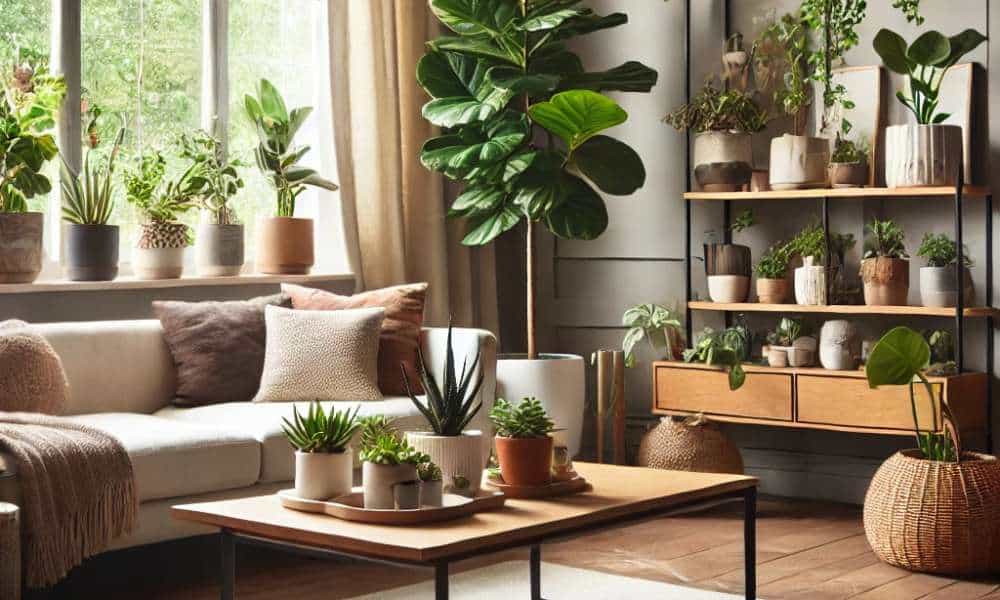Bringing plants into your living room is a simple yet transformative way to elevate your home’s ambiance. Whether you prefer lush greenery or a minimalist touch, the right plant arrangement ideas in living room can add charm, freshness, and a hint of nature to your space. From stylish planters to creative displays, there are countless ways to incorporate plants that reflect your personality while enhancing your décor. Let’s explore some inspiring ideas to turn your living room into a lively, refreshing oasis!
1. Why Add Plants to Your Living Room?
Indoor plants are more than decorative pieces; they are silent benefactors that enrich your environment. Scientifically, they enhance air quality by absorbing carbon dioxide and releasing oxygen. Many species, such as spider vegetation and peace lilies, are proven to remove toxins, creating a healthier living space.
On an emotional level, plants have a calming effect. Their verdant presence reduces stress, increases focus, and can even foster creativity. Aesthetically, vegetation brings a dynamic visual appeal, softening harsh corners and adding layers of texture to your living room. Whether you’re aiming for a bohemian haven or a minimalist retreat, plants adapt effortlessly to every design style.
2. Choosing the Right Plants for Your Living Room
Selecting the right plants for your living room depends on three primary factors: light availability, space constraints, and maintenance preferences.
Low-Maintenance Plants for Beginners
- Snake Plant: A hardy option that thrives on neglect, ideal for busy homeowners.
- Pothos: With its cascading vines, it adds elegance to shelves and mantels.
- ZZ Plant: Perfect for low-light spaces, this plant is nearly indestructible.
Best Plants for High-Light Areas
- Fiddle Leaf Fig: A favorite among design enthusiasts, it makes a dramatic statement.
- Bird of Paradise: With its lush, tropical leaves, it transforms any room into a vacation-like escape.
Understanding your living room’s conditions and personal commitment to plant care will ensure your green companions thrive for years.
3. Plant Arrangement Based on Living Room Size
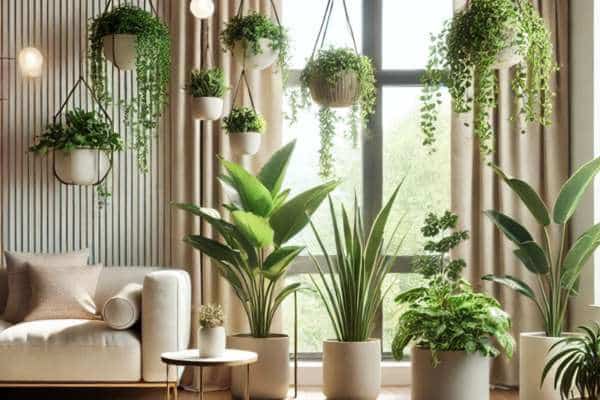
Every living room, regardless of size, has the potential to house plants in creative and functional ways.
Small Living Room Arrangements
Maximize vertical spaces by installing wall-mounted shelves or hanging planters. Compact varieties like succulents and ferns fit snugly on coffee tables or window sills. Use tiered stands to create height variations without consuming too much floor space.
Large Living Room Arrangements
In expansive spaces, group plants of varying heights to create a mini jungle. Incorporate larger specimens like Monstera or Rubber Plant to fill empty corners. Experiment with symmetrical arrangements by flanking the sofa with identical vegetation or mix textures for a more organic feel.
4. Creative Ways to Display Plants
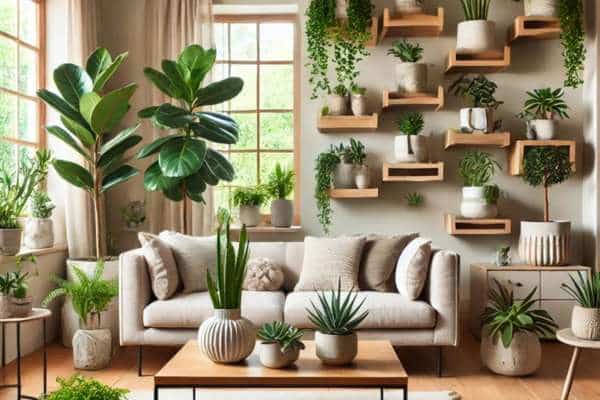
The way you display plants can completely alter the dynamic of your living room. Whether suspended, mounted, or placed strategically on surfaces, creative arrangements breathe new life into the space.
Hanging Planters
Hanging planters bring plants to eye level, adding a sense of dimension. Opt for sleek, ceiling-mounted designs or macramé hangers for a bohemian flair. These work particularly well with trailing vegetation like String of Pearls or English Ivy, creating a cascading effect that’s both elegant and modern.
Wall-Mounted Gardens
Transform an empty wall into a lush living tapestry. You can install shelves to hold potted plants or invest in a living wall system for a bold statement. Cascading plants or those with colorful foliage work wonderfully here, adding a pop of natural vibrancy to your décor.
Tabletop Displays
For those who prefer a more traditional approach, tabletop arrangements offer endless versatility. Use decorative pots to house small succulents, cacti, or flowering plants. A beautifully curated centerpiece with a mix of textures and heights can elevate your coffee table, sideboard, or dining table, creating a conversation starter that’s both stylish and functional.
5. Styling Plants with Furniture
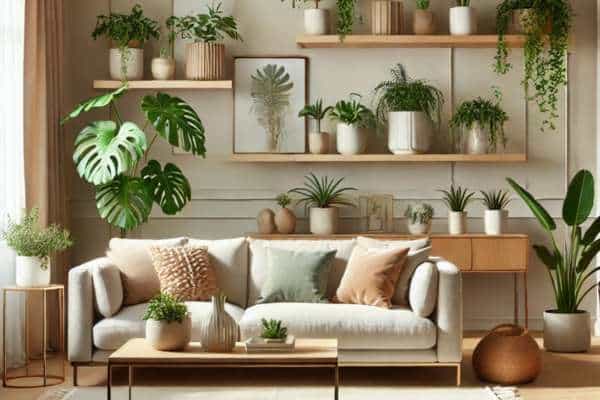
Incorporating plants into your furniture layout can create a cohesive and stylish living room. Place vegetation near accent chairs or bookshelves to frame your furniture with natural beauty. A tall plant like a Rubber Tree can fill an empty corner, while trailing greenery on a shelf adds depth. For a functional touch, use vegetation as dividers to segment open spaces, blending utility with aesthetics. Match pot colors with furniture tones for a unified look or contrast for a bold design statement.
6. Incorporating Large Plants
Large plants make excellent statement pieces in living rooms. Consider using a tall Fiddle Leaf Fig or a dramatic Bird of Paradise to anchor an area. These vegetation can stand alone or complement surrounding furniture. Choose pots with interesting textures or colors to emphasize the plant’s presence. Placement is key—position them in well-lit areas near windows or in unused spaces to enhance their visual impact. Large plants not only draw attention but also create a sense of grandeur.
7. Mixing and Matching Plant Types
Pairing different plants adds variety and intrigue to your living room. Combine leafy vegetation like Monstera with succulents for a mix of shapes and textures. Use flowering vegetation to add vibrant colors, breaking the monotony of green. Arranging vegetation of varying heights can create a tiered effect, making your display more dynamic. Try grouping vegetation with similar care requirements together to simplify maintenance while ensuring they thrive. The mix of types adds a curated and artistic vibe to your living space.
8. Seasonal Plant Arrangement Ideas
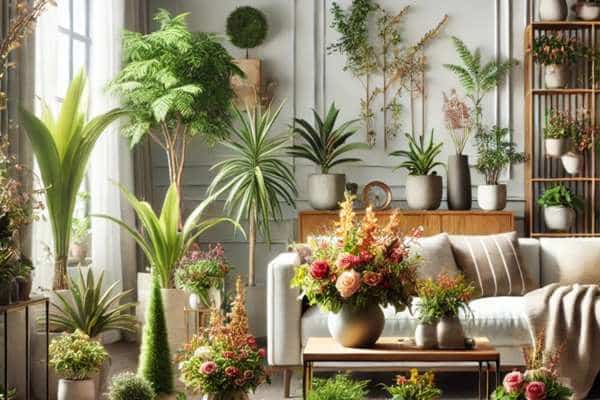
Rotate your plant arrangements to align with the seasons. In spring, use flowering plants like Peace Lilies or Anthuriums to introduce freshness. During the holidays, decorate with poinsettias or add fairy lights to your planters for a festive touch. Summer is perfect for vibrant tropical plants, while autumn arrangements can feature warm-colored foliage. Seasonal changes keep your living room décor exciting and ensure that vegetation reflects the mood of the time, offering a constantly evolving aesthetic.
9. The Role of Lighting in Plant Placement
Lighting is crucial for plant health and aesthetics. Identify the natural light zones in your living space and choose plants accordingly. For low-light corners, go with Snake Plant or Peace Lily. In brighter spots, position sun-loving vegetation like Aloe Vera. If natural light is insufficient, invest in full-spectrum grow lights to support your vegetation.
10. DIY Plant Stands and Decor
Personalized plant stands and pots elevate the uniqueness of your arrangement. Use reclaimed wood or upcycled materials to craft bespoke stands. For pots, experiment with hand-painted designs or textured finishes to complement your living room theme. DIY solutions are not only cost-effective but also add a personal touch to your plant displays.
11. Arranging Plants for Maximum Health Benefits
Strategically place air-purifying vegetation like Spider Plant or Boston Fern near seating areas for optimal impact. In drier climates, use humidity-loving plants like Calathea or Areca Palm to naturally increase moisture levels. Place vegetation near windows to minimize outdoor noise while enhancing your room’s air quality.
12. Caring for Your Living Room Plants
Proper care ensures your plants thrive and remain beautiful. Establish a watering schedule based on plant type and environmental factors. Use well-draining soil and add fertilizer during growth periods. Regular pruning prevents overgrowth and keeps your vegetation looking neat and tidy. Report every couple of years to refresh soil nutrients and accommodate growth.
13. Common Mistakes in Plant Arrangements
Avoid overcrowding plants, as this can impede airflow and increase the risk of pests. Pay attention to individual light and temperature needs—placing a sun-loving plant in a shady spot can be detrimental. Always choose pots with drainage holes to prevent root rot.
Conclusion
Plants have the power to redefine your living space, transforming it into a sanctuary of tranquility and beauty. By experimenting with different arrangements, you can create a space that reflects your personality while reaping the numerous benefits vegetation provides. So, roll up your sleeves, pick your favorites, and begin your green transformation today!

